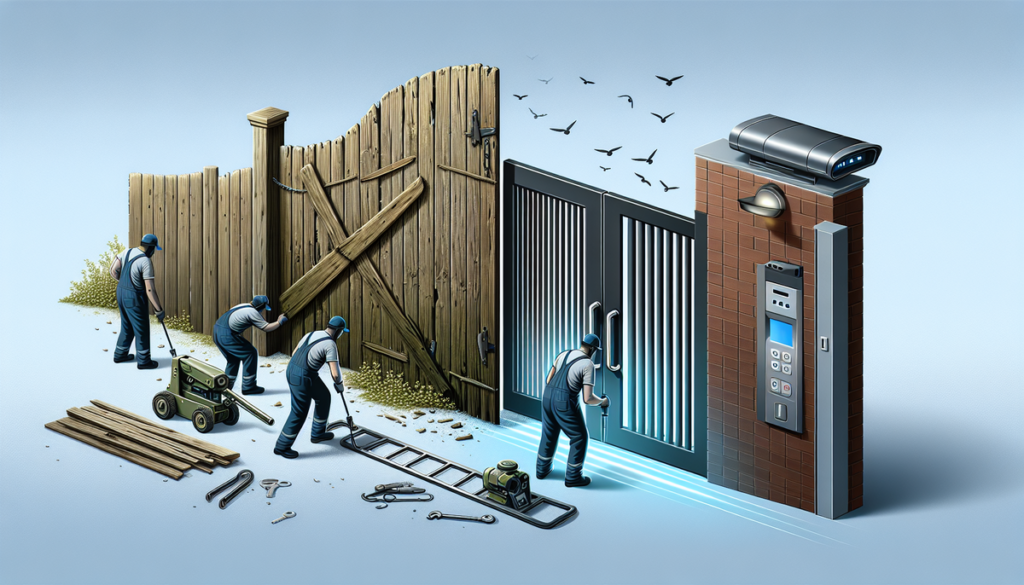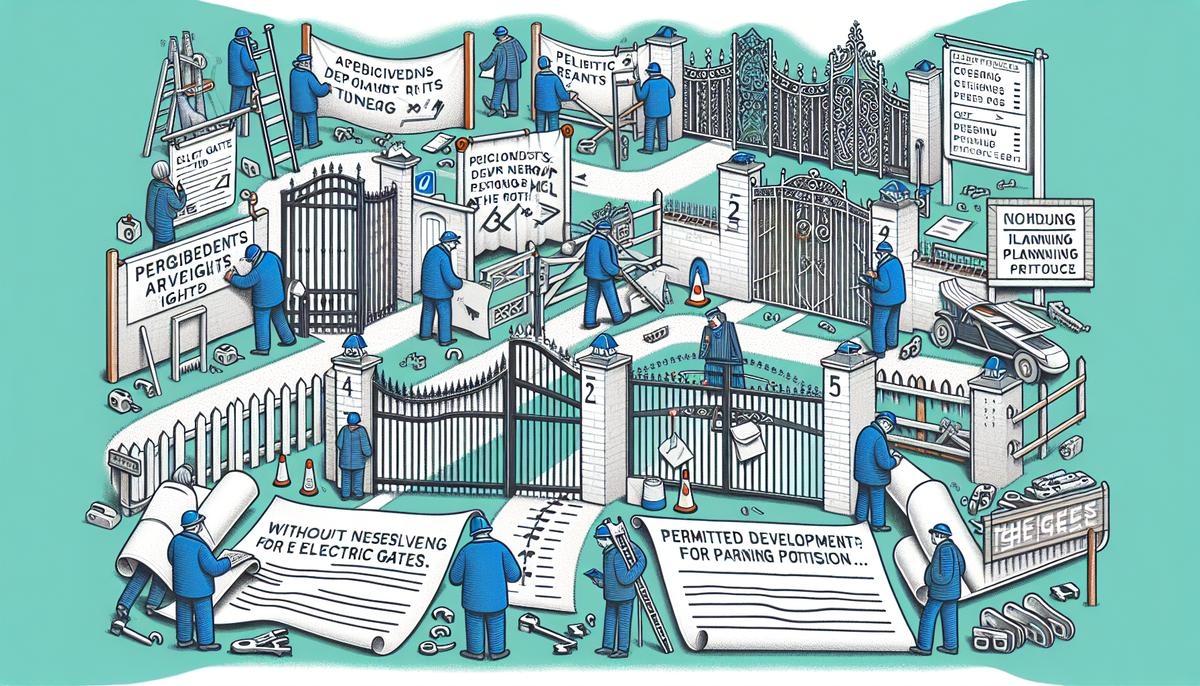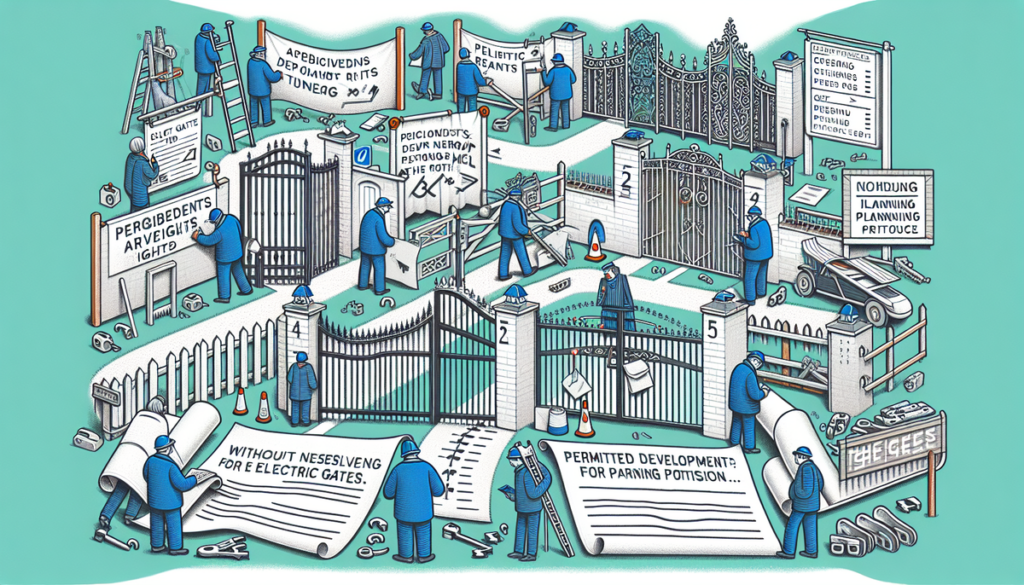Do You Need Planning Permission for Electric Gates?
Are you contemplating installing electric gates but unsure about planning permissions? You’re in the right place. Do you need planning permission for electric gates? Height, vicinity to public highways, and designated land statuses are pivotal in the permissions process. This article breaks down the essentials, guiding you through the conditions and exceptions to consider for a hassle-free installation.
Key Takeaways
- Planning permission for electric gates depends on the gate’s location, height, and impact on the local area, with stricter regulations in sensitive zones such as conservation areas or historical sites.
- Electric gates for residential properties may fall under Permitted Development rights, usually not requiring planning permission unless the gates exceed certain heights or the property has a specific designation like being listed or in a conservation area.
- When planning permission is necessary, applicants should consult professional advisors, submit detailed plans, respond to feedback if refused and ensure compliance with environmental, safety, and local character conditions.
Understanding the Essentials of Planning Permission for Electric Gates
Planning permission acts as a formal nod from local planning authorities for constructing new or altered structures, including electric gates. But why do we need planning permission to put up or alter or install electric gates? The primary reason is to ensure that these architectural additions do not hurt local areas, historical sites, or environmental health.
In certain sensitive areas such as Conservation Areas, National Parks, Areas of Outstanding Natural Beauty, or World Heritage Sites, installing modern gates may require additional permissions. Some considerations that come into play include:
- Potential impacts on historic interest
- Local character
- Environmental Health
- Public spaces
- Privacy of dwellings
Therefore, compliance with local council regulations is paramount. Ensuring that your electric gates meet all requirements avoids legal issues and fosters a sense of community, respect, and responsibility.
The Role of Height and Location in Planning Permission
The height and location of your gates play a crucial role in determining if you need planning permission. For instance, if your gates open onto a public highway, they’re limited to a metre high or less; anything above this height requires planning permission from your local planning authority. However, you can erect gates up to 2 metres high without needing planning permission if they’re located on a private or unadopted road.
But what happens if your planning permission is denied due to the gates’ proximity to a highway? In such cases, you might have to set the gates back from the road next to a highway to prevent traffic obstruction. Navigating these rules may seem a tad complex, but understanding how height and location factor into planning permissions is a significant step toward a smooth and legal installation process.
When Existing Gates Come into Play


What happens when you’re merely replacing an existing gate with a new one? The good news is that planning permission is typically not required for this process. For instance, if your new gate is below one meter in height and next to a road or public footpath, planning permission is usually not necessary unless the property is a listed building or located in a conservation area.
So, whether you’re sprucing up your property with a fresh gate design or replacing a worn-out gate with a new one of the same size, the process is generally hassle-free and does not require planning permission. However, it’s always a good practice to check with your local council to ensure you’re following the correct procedures.
The Impact on Local Character and Conservation Areas
When it comes to installing electric gates in conservation areas or other designated areas, the rules become a bit more stringent. The aesthetic considerations for new developments like electric gates in these areas are more rigorous to maintain the locale’s integrity and preserve its local character.
Suppose your property is within a conservation area, National Park, or Area of Outstanding Natural Beauty (AONB). In that case, you may face additional regulations impacting the Permitted Development rights for electric gates. Therefore, the design and materials of your gates should align with the character of your property and its surroundings to comply with planning regulations. Whether you opt for metal, wood, or aluminium, each material offers unique aesthetic and durability benefits and can be tailored to different driveway layouts.
Navigating Permitted Development Rights for Electric Gates


While planning permission is a significant aspect to consider when installing electric gates, another concept to understand is permitted development rights. These rights grant authorisation for certain types of building works, including the installation of fences, walls, and gates, without the need for a formal planning application. However, these works must adhere to predefined conditions to limit the impact on the locale.
In most instances, automated electric gates installed on residential properties do not necessitate planning permission when they conform to specific requirements regarding their height, positioning, and the building’s historic status. This means you can install or modify existing electric gates without needing planning approval, provided the gate’s height remains below one metre next to a highway and below two metres high in all other positions around the property.
However, the rules vary for commercial properties, making the understanding of permitted development rights a vital part of the planning process for electric gate installation, especially for businesses and larger premises.
Clarifying Permitted Development for Residential Properties
If you’re a homeowner, you’ll be happy to know that electric gates on residential properties can be installed under Permitted Development without planning permission if they do not exceed 2 meters in height. However, if your electric gates are over two meters high and are away from highways, for example, you might need to apply for planning permission.
Permitted development rights enable homeowners to carry out certain improvements or extensions, such as installing electric gates, without needing to seek planning permission, provided the changes are proportionate. Homeowners do not need planning permission to replace an existing gate with a new one of the same or a lesser height unless the gate is associated with a listed building. However, gates that open outwards onto public pavements or highways require planning permission as they are not permitted to open directly onto such spaces.
Commercial Projects and Permitted Development
In contrast to residential properties, commercial projects often require submitting a planning application to the local planning authority when installing electric gates. Commercial buildings have permitted development rights that can include extensions and alterations, subject to size limits for industrial and warehouse buildings, as well as offices, shops, or service establishments.
This means that if you’re planning to install electric gates on a commercial property, it’s crucial to check with your local planning authority to understand the specific rules and requirements that apply. This way, you can ensure a smooth and legal installation process that adheres to all relevant regulations.
Seeking Approval: How to Apply for Planning Permission
So, how do you go about applying for planning permission? The first step is to engage professional consultants such as architects or electric gate installers. They can help you understand and navigate the planning permission process effectively. Planning permission for driveway gates is applied through the local council, which assesses the application based on specific criteria.
You should seek planning permission in specific circumstances, such as when an Article 4 direction applies or if your property is adjacent to a neighbouring listed building with gates that will be within the boundaries. Your application should include detailed plans illustrating the design of the gates and showing their intended location on the property and public highway.
Keep in mind that the application process and requirements for planning permissions may vary regionally; therefore, it’s advised to contact local authorities for tailored guidance. Ursa Gates can offer expert advice and support throughout the home or commercial planning permission application, streamlining the process for the applicant.
Responding to a Planning Condition or Refusal
What happens if your application for planning permission for electric gates is refused? Don’t lose heart. You can amend your proposals based on the local authority’s feedback and resubmit your application. To address the refusal effectively, focus on the specific reasons for rejection provided by the planning authority.
Consider the following steps to improve your chances of receiving approval for your electric gates:
- Demonstrate the historical existence of a gate if relevant.
- Propose the installation of a different type of gate that may be more acceptable to the local authority.
- Resubmit your application after careful consideration and addressing the planning authority’s concerns.
By following these steps, you can significantly improve the chances of receiving approval for your electric gates.
Environmental Health Considerations
Planning to install electric gates also involves giving due consideration to environmental health. Properties with listed status require listed building consent before electric gate installation due to protection laws for historical significance. In conservation areas, stricter criteria apply for planning conditions for electric gate installations, necessitating checks with local authorities even if generally permitted development criteria are met.
Moreover, compliance with legal safety regulations is mandatory during powered gate installation to prevent public risk. Responsible electric gate installation avoids creating safety hazards and nuisances within the community, thereby contributing to a harmonious living environment.
Enhancing Your Property with Automatic Electric Gates


While understanding planning permissions and regulations is essential, let’s not forget the many benefits of installing automatic electric gates. Adding these gates to a property can increase its market value due to the perceived luxury and improved aesthetic appeal. Moreover, installing automatic electric gates can significantly enhance a property’s security by allowing remote monitoring and control, making unauthorised access more difficult. They can also add convenience by eliminating the need for manual gate operation.
Automatic gates offer a range of benefits, making them a worthy consideration for homeowners and businesses alike. Some of these benefits include:
- Less maintenance is required compared to manual gates, making them cost-effective in the long term
- Enhanced property appeal for homeowners
- Improved security for businesses
Electronic Gates for Driveways: Combining Aesthetics and Functionality
Electronic gates offer a perfect blend of aesthetic appeal and practical functionality. They enhance a property’s visual presentation while contributing to its security and convenience. You can choose from a variety of materials for your gates. Steel and iron are favoured for their durability, while aluminium is selected for being lightweight and resistant to rust.
Wooden gates, while being the most affordable option, require frequent maintenance and may be susceptible to damage. On the other hand, metal gates require less upkeep, offering a balance of cost and convenience. Moreover, modifying an existing gate to include automation does not require new planning permission, simplifying the process for homeowners who wish to upgrade their gates.
The Long-Term Investment: Weighing Up Automatic Gates Cost
When considering the installation of automatic gates, it’s essential to view it as a long-term investment. While the initial costs of electric gates can be significant, they can enhance a property’s value by improving its aesthetic appearance and security, potentially leading to lower insurance premiums due to reduced risk of burglary.
The cost of electric gates varies significantly depending on:
- The choice of materials
- The complexity of the design
- Gate size
- The automation features selected
Automatic gate opener costs differ depending on the system’s duty level, with hydraulic openers typically being the most expensive option. However, considering the long-term benefits, the cost of automatic gates is a worthy investment for most property owners.
Collaborating with Neighbours and the Community


Installing electric gates isn’t just about adhering to local regulations and enhancing your property’s value; it’s also about maintaining good relations with your neighbours and contributing positively to your community. Discussing your plans for driveway gate installation with neighbours is essential. Not only does it foster a sense of community, but it also helps preempt potential legal misunderstandings regarding ownership and boundary issues that could lead to disputes.
Open communication with neighbours before embarking on the installation process can lead to amicable solutions and improved community relations. Moreover, building a positive relationship with neighbours allows for a better understanding of their perspectives on the project, possibly preventing objections or issues before they arise.
Addressing Neighbourly Concerns Early On
Engaging with your neighbours early on in the planning process is a proactive approach that can prevent potential disputes. Discussing your plans and addressing any concerns they may have can provide an opportunity to make adjustments that could alleviate these concerns. By focusing on calm discussions and potential solutions, you can effectively address any issues neighbours have with the installation of gates.
Keeping records of these conversations can also be useful for future reference if neighbourly disputes over the gate installation arise. This approach not only ensures a smoother installation process but also fosters a sense of community and mutual respect.
Contributing to the Local Environment Responsibly
When installing electric gates, it’s also important to consider your contribution to the local environment. You should aim to ensure your gates do not negatively impact the local ecosystem, maintaining a balance between enhancing your property and preserving the natural surroundings. One way to achieve this is by choosing to alter fences in a way that complements the electric gates and the environment.
This approach not only aligns with responsible property development practices but also fosters a sense of respect for the local environment and community. After all, your property is part of a wider community, and your actions can significantly impact the collective living experience.
Summary
Installing electric gates is a multifaceted process that involves understanding and navigating planning permissions, considering the implications of gate height and location, and engaging with neighbours and the community. From enhancing your property’s aesthetic appeal to improving security and increasing property value, the benefits of automatic electric gates are manifold. However, it’s important to approach the installation process responsibly, considering the local environment and preserving good community relations.
Understanding the nuances of planning permissions, permitted development rights, and local regulations can ensure a smooth and legal installation process. Whether you’re a homeowner looking to enhance your property, a business seeking improved security, or a property developer working on a commercial project, understanding these aspects is crucial to a successful electric gate installation.
Frequently Asked Questions
Do I need planning permission to install electric gates?
Yes, you may need planning permission to install electric gates, especially if your property is in a sensitive area or if the gates exceed certain height requirements. It’s advisable to consult your local planning authority for specific guidelines.
Can I replace my existing gate without planning permission?
Yes, you can replace your existing gate without planning permission as long as the new gate is the same or lower in height and not associated with a listed building.
What are permitted development rights?
Permitted development rights allow for certain building works, such as fences and walls, without requiring a formal planning application.
What should I do if my planning permission application is refused?
If your planning permission application is refused, you can revise your plans according to the feedback from the local authority and submit a new application. This will give you another chance to address any concerns and potentially gain approval for your project.
How do electric gates add value to my property?
Installing electric gates can increase your property’s aesthetic appeal and security, potentially raising its market value and lowering insurance premiums due to the reduced risk of burglary.


